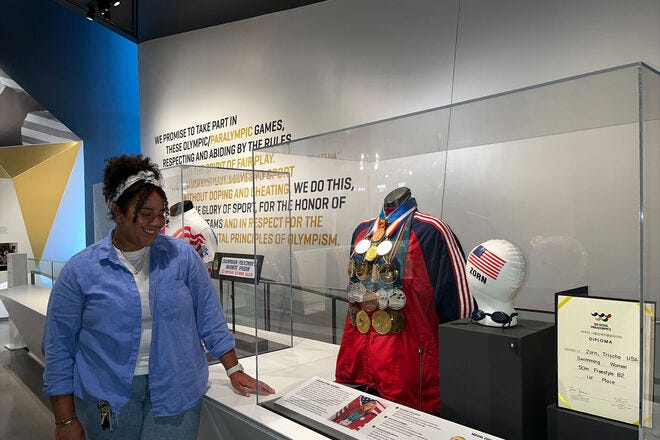US Olympic museum workers cite 5 cool things everyone should see
The U.S. Olympic and Paralympic Museum cost $91 million to build — Photo courtesy of Jason O’Rear / U.S. Olympic and Paralympic Museum
Colorado Springs, Colorado, is the hub of all things Olympic. Since 1978, it’s been the home of the U.S. Olympic and Paralympic Committee, and it’s where approximately 15,000 athletes perfect their skills each year at the U.S. Olympic and Paralympic Training Center. So, it was only fitting that Colorado Springs serve as the site for a museum celebrating the history and achievements of Team USA athletes.
Voted among the 10 best attractions for sports fans in the country, the U.S. Olympic and Paralympic Museum opened its doors in 2020. The visually striking Olympic museum, designed by Diller Scofidio + Renfro, cost about $91 million to build. In addition to special exhibitions, the museum houses 12 galleries showcasing priceless artifacts and interactive exhibits that tell the inspiring stories of Olympic and Paralympic athletes over the past century.
It typically takes 1.5 hours to go through the U.S. Olympic Museum on your own, and the museum offers guided tours for an additional fee. We asked those who work at the Olympic museum in Colorado Springs which museum exhibits and artifacts are their favorites. This is what they had to say.
Bob Beamon’s record-shattering long jump
 Chef Thomas Hartwell is impressed by track and field star Bob Beamon’s famous long jump — Photo courtesy of U.S. Olympic and Paralympic Museum
Chef Thomas Hartwell is impressed by track and field star Bob Beamon’s famous long jump — Photo courtesy of U.S. Olympic and Paralympic Museum
Thomas Hartwell, executive chef of the museum’s Flame Café, says a floor decal marking the “flight path” of track and field Olympian Bob Beamon is his favorite. Beamon set a long jump world record at the 1968 Olympic Games in Mexico City.
“It is amazing to stand here and see how long 29 feet, 2 ½ inches looks and imagine his flight path,” Hartwell says.
It took almost 23 years to break Beamon’s record; he still holds the record for second-longest wind-legal jump.
Serena Williams’ tennis ball and shoe
 In the Summer Games Gallery, you’ll find relics from numerous U.S. Olympians — Photo courtesy of U.S. Olympic and Paralympic Museum
In the Summer Games Gallery, you’ll find relics from numerous U.S. Olympians — Photo courtesy of U.S. Olympic and Paralympic Museum
For Erin Nelson-Meek, director of guest experience, the answer comes easily: a signed tennis ball and shoe of tennis star Serena Williams. You can find these artifacts in the Summer Games Gallery.
“They were the first things I took a picture of when I started working here in May 2020,” she says. “Seeing something from Serena in our museum is what made me realize, ‘Wow, it’s kind of a big deal to be working here!’”
Sports & Outdoors: Experience game day heaven at these winning sports attractions
It’s a big deal that sometimes can result in brushes with Olympian royalty. Nelson-Meek recalls the time she met Connor Fields, best known as the first American to win an Olympic gold medal in BMX bike racing at the 2016 Summer Games in Rio de Janeiro. Fields showed up at the Olympic museum in Colorado Springs to see his bike and uniform on display.
“It was one of the few times I’ve been flabbergasted working here,” she says. “You never know who is going to walk through the front door!”
An homage to the 1980 U.S. Olympic team
 August Jimeson cites the museum’s tribute to the 1980 U.S. Olympic team as her favorite — Photo courtesy of U.S. Olympic and Paralympic Museum
August Jimeson cites the museum’s tribute to the 1980 U.S. Olympic team as her favorite — Photo courtesy of U.S. Olympic and Paralympic Museum
August Jimeson, an accounting assistant at the museum, says she’s most moved by an exhibit that pays homage to the American athletes who qualified to compete in the 1980 Olympic Games in Moscow. Just months before the Games began, the United States led a boycott of the Olympics to protest the then-Soviet Union’s invasion of Afghanistan.
“There are no artifacts from these games,” says Jimeson. “The [museum] honors these athletes by telling their story and sharing the names of each member of the 1980 U.S. Olympic team.”
Artist Leroy Neiman’s original work

Hannah Henthorne, a sales and development coordinator at the museum, says the Art of the Olympian exhibit, featuring the original artwork of Leroy Neiman, is most moving to her. Neiman served as the official painter of five Olympic Games, committing to canvas pivotal moments in Olympic history.
“The human body in motion interpreted on these vibrant canvases is a reminder that each athlete is their own artist, constantly fine-tuning their craft to deliver a winning product,” Henthorne says. “This gallery is so energizing.”
Swimmer Trischa Zorn-Hudson, the most decorated Paralympian
 Oriana Va’i helped install this impressive exhibit at the U.S. Olympic and Paralympic Museum — Photo courtesy of U.S. Olympic and Paralympic Museum
Oriana Va’i helped install this impressive exhibit at the U.S. Olympic and Paralympic Museum — Photo courtesy of U.S. Olympic and Paralympic Museum
Oriana Va’i, a museum archival specialist, points to the Trischa Zorn-Hudson exhibit as her favorite.
“I had the pleasure of being part of the team that installed this exhibit,” says Va’i. “Being able to physically feel and place some of her 55 medals in the exhibit made me appreciate her dedication to excellence and admire how extraordinary she is.”
Zorn-Hudson was born with a genetic eye condition that left her blind. In addition to her 55 medals, the Paralympic swimmer was the first visually impaired athlete to be awarded a NCAA Division 1 scholarship. Today, she works as an attorney with the U.S. Department of Veteran Affairs.
Sports & Outdoors: 15 hall of fame locations that will dazzle any sports fan
Va’i says her favorite “museum moment” was when wheelchair fencing Paralympian Terry “Scooter” Hayes visited the Colorado Springs museum for the first time.
“I had been emailing Scooter for almost a year while planning our new wheelchair fencing exhibit,” she says. “[Hayes] flew in from across the country to celebrate the start of the Paris 2024 Games at the museum and to see our new exhibit that features her fencing equipment from the Tokyo 2020 Paralympic Games.
“It was so emotionally fulfilling to see an athlete’s reaction to their artifacts being displayed in the museum, and it reminded me of the impact our museum can make in someone’s life,” Va’i says.
What to know before you go
Hours: The U.S. Olympic and Paralympic Museum is open daily from 10 a.m. to 5 p.m.
Parking: Paid parking is available across the street.
Admission: Tickets can be purchased up to 90 days in advance. You can purchase day of, but entry times may be limited. There’s also this Groupon deal.
Discounts: Discounts are available for youth, college students, seniors, military, first responders, and health care workers with valid identification. Admission is waived for children age 4 and younger.
Memberships: Memberships are available, offering individuals and families an affordable way to return throughout the year.
Accessibility: Accessibility features at the museum include audio description tracks, open captions, universal keypads, assisted listening systems, RFID-triggered customizations, and wheelchair-accessible ramps.
Where to fuel up: The on-site Flame Café offers casual dining from 11 a.m. to 4 p.m. No reservations required.




